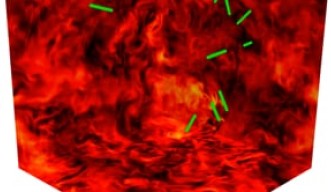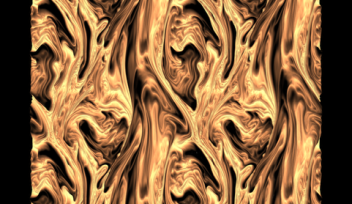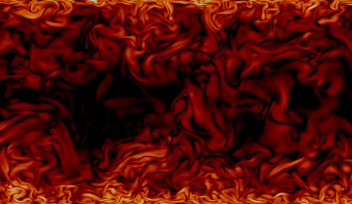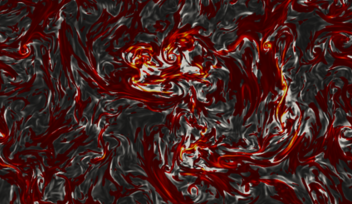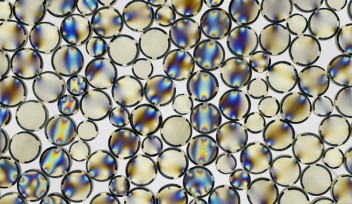Fiber tracking method delivers important new insights into turbulence

Highlights
- Turbulent flows are random, chaotic and occur across many scales, making them notoriously difficult to measure
- Scientists have now developed a new and improved means of measuring turbulent flows, using fibers rather than tracer particles
- The team tested their method by using both computer simulations and lab experiments
- The researchers used fibers of different lengths to measure the turbulent flow at many different scales
- The shortest fibers allowed the team to measure the energy dissipation rate, a crucial quantity needed to characterize turbulent flows
Press Release
Whether it’s heart murmurs and pipeline transport of oil, or bumpy airplanes and the dispersal of pollutants, turbulence plays an important role in many everyday events. But despite being commonplace, scientists still don’t fully understand the seemingly unpredictable behavior of the swirls and eddies in turbulent flows.
Now, a new technique for measuring turbulent flows has been developed by an international collaboration of scientists from the Okinawa Institute of Science and Technology Graduate University (OIST) in Japan, along with the University of Genova, Italy, KTH Stockholm, Sweden and ETH Zurich, Switzerland. By using fibers rather than particles – the usual method of measurement – the researchers could get a more detailed picture of turbulent flows. Their method was reported on 17th September in the journal, Physical Review X.
“Turbulence is a very unique and complicated phenomena, it’s even been called the last unsolved problem in classical physics,” said Dr. Stefano Olivieri, a postdoctoral researcher from the Complex Fluids and Flows Unit at OIST, who was an author of the study. “It’s difficult to predict, difficult to simulate, and difficult to measure.”
Measuring turbulent flows is a pressing challenge for physicists for numerous reasons. Not only is turbulence characterized by its chaotic and random nature, but it also occurs across many scales at once. In turbulent flows, the swirling vortices of fluid break down into eddies that are smaller and smaller in scale, until eventually the eddies are so small and viscous that the kinetic energy of the fluid is transferred to the environment as heat.

Currently, the most common way to measure turbulent flows is by tracking the movement of particles, called tracers, that are added to the fluid. These particles are tiny and of similar density to the fluid, and so move at the same speed and in the same direction as the flow.
But in order to observe how each swirl of fluid is moving, looking at how one particle moves isn’t enough. Physicists need to be able to determine how two particles that are a specific distance apart move in relation to each other. The smaller the eddy, the closer together the two particles need to be to characterize the motion of the vortex.
To make matters more challenging, one of the defining features of turbulence is its diffusivity – a turbulent flow will spread apart over time, and so too will the tracers, especially in open flows, like an ocean current. In many cases, tracers can quickly spread too far apart to measure how the eddies are behaving.
“Every tracer particle is moving independently of each other, so you need lots of tracer particles in order to find ones that are the right distance apart,” explained Professor Marco Rosti, who leads the OIST Complex Fluids and Flows Unit.
“And too many tracer particles can actually disrupt the flow,” he added.
To circumvent this issue, the research team developed an innovative and easy solution to the problem: using fibers instead of tracer particles.
The researchers created a computer simulation where fibers of different lengths were added to a turbulent flow. These fibers were rigid, which kept the ends of each fiber a fixed distance apart. By tracking how each fiber moved and rotated within the fluid over time, the researchers were able to build up a picture that encompassed the full scale and structure of the turbulent flow.
“By using rigid fibers, we can measure the difference in the speed and the direction of the flow at two points a fixed distance apart, and we can see how these differences change depending on the scale of the eddy. The shortest fibers also allowed us to accurately measure the rate at which the kinetic energy of the fluid is transferred from the largest to the smallest scales, where it is then dissipated by heat. This value, called the energy dissipation rate, is a crucial quantity in the characterization of turbulent flows,” said Prof. Rosti.
The researchers also performed the same experiment in the laboratory. They manufactured two different fibers, one made from nylon and the other from a polymer called polydimethylsiloxane. The team tested both these fibers by adding them to water tank containing turbulent water and found that the fibers gave similar results to the simulation.

However, using rigid fibers comes with one important caveat, the scientists emphasized, as the overall movement of the fiber ends is restricted.
“Due to the fiber rigidity, the fiber ends can’t move towards each other, even if that’s the direction of the flow. That means that a fiber cannot fully represent the movement of the flow in the same way that tracer particles can,” explained Dr. Olivieri. “So before we even began simulations or lab experiments, we first needed to develop a suitable theory that took these limitations of movement into account. This was perhaps the most challenging part of the project.”
The researchers also measured the same turbulent flow in the laboratory the conventional way, by adding a high concentration of tracer particles to the water tank. The results obtained from the two different methods were similar, verifying that the fiber method and the newly developed theory gave accurate information.
Moving forward, the researchers hope to expand their method to incorporate flexible fibers that have less restriction on how they move. They also plan to develop a theory that can help measure turbulence in more complex non-Newtonian fluids that behave differently from water or air.
“This new technique has a lot of exciting potential, especially for scientists studying turbulence in large, open flows like ocean currents,” said Prof. Rosti. “And being able to easily measure quantities that were previously difficult to obtain moves us one step closer to fully understanding turbulence.”
Article Information
Title: Fiber Tracking Velocimetry for two-point statistics of turbulence
Journal: Physical Review X
Authors: Stefano Brizzolara, Marco Edoardo Rosti, Stefano Olivieri, Luca Brandt, Markus Holzner and Andrea Mazzino
DOI: https://doi.org/10.1103/PhysRevX.11.031060
Date: 17 September 2021
The header image from Wikimedia Commons shows turbulence created by an aircraft. It was catalogued by Langley Research Center of the United States, NASA.
Specialties
Research Unit
For press enquiries:
Press Inquiry Form











